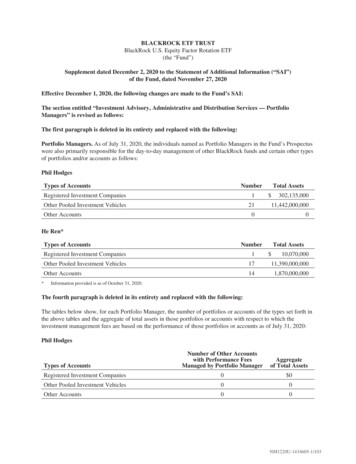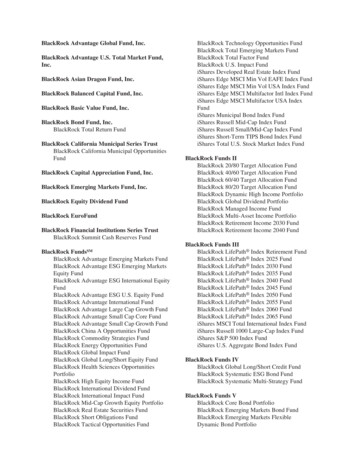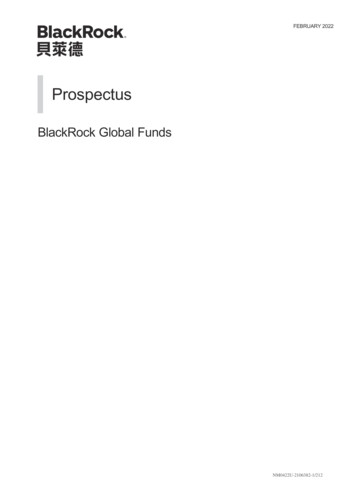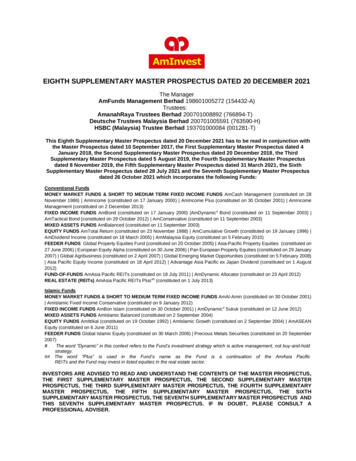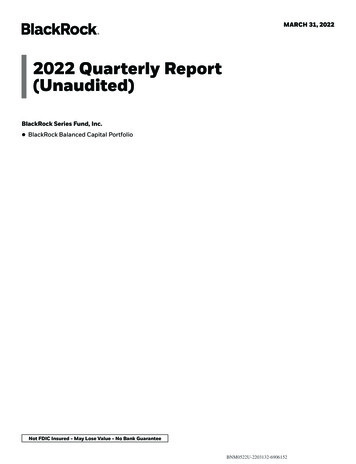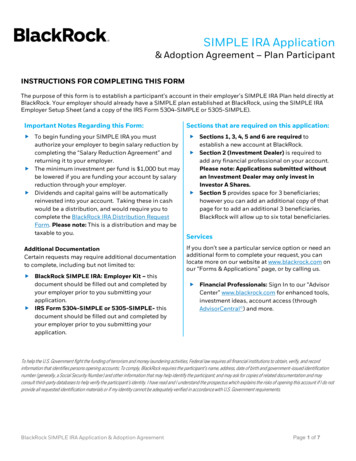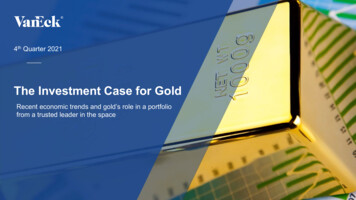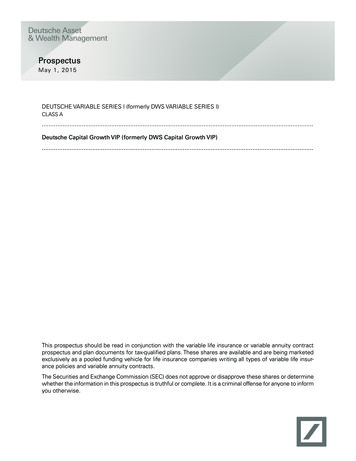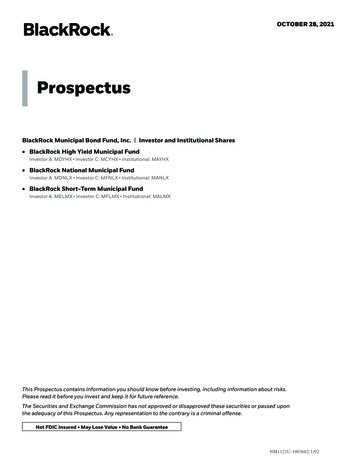
Transcription
OCTOBER 28, 2021ProspectusBlackRock Municipal Bond Fund, Inc. Investor and Institutional Shares BlackRock High Yield Municipal FundInvestor A: MDYHX Investor C: MCYHX Institutional: MAYHX BlackRock National Municipal FundInvestor A: MDNLX Investor C: MFNLX Institutional: MANLX BlackRock Short-Term Municipal FundInvestor A: MELMX Investor C: MFLMX Institutional: MALMXThis Prospectus contains information you should know before investing, including information about risks.Please read it before you invest and keep it for future reference.The Securities and Exchange Commission has not approved or disapproved these securities or passed uponthe adequacy of this Prospectus. Any representation to the contrary is a criminal offense.Not FDIC Insured May Lose Value No Bank GuaranteeNM1121U-1903682-1/92
Table of ContentsFund OverviewKey facts and details about the Funds listed in this prospectus,including investment objectives, principal investment strategies,principal risk factors, fee and expense information and historicalperformance informationKey Facts About BlackRock High Yield Municipal Fund . 3Key Facts About BlackRock National Municipal Fund . 11Key Facts About BlackRock Short-Term Municipal Fund. 20Details About the FundsHow Each Fund Invests . 28Investment Risks. 32Account InformationManagement of the FundsInformation about account services, sales charges and waivers,shareholder transactions, and distributions and other paymentsHow to Choose the Share Class that Best Suits Your Needs .Details About the Share Classes .Distribution and Shareholder Servicing Payments.How to Buy, Sell, Exchange and Transfer Shares .Account Services and Privileges .Funds’ Rights .Participation in Fee-Based Programs .Short-Term Trading Policy .4044495056575858Information about BlackRock and the Portfolio ManagersBlackRock.Portfolio Manager Information .Conflicts of Interest .Valuation of Fund Investments .Dividends, Distributions and Taxes.6062636465Financial HighlightsFinancial Performance of the Funds . 67General InformationShareholder Documents. 76Certain Fund Policies . 76Statement of Additional Information . 77GlossaryGlossary of Investment Terms . 78Intermediary-DefinedSales Charge WaiverPoliciesFor More InformationIntermediary-Defined Sales Charge Waiver Policies. A-1Funds and Service Providers . Inside Back CoverAdditional Information.Back CoverNM1121U-1903682-2/92
Fund OverviewKey Facts About BlackRock High Yield Municipal FundInvestment ObjectiveThe investment objective of BlackRock High Yield Municipal Fund (the “High Yield Fund”or the “Fund”) is to provideshareholders with as high a level of income exempt from Federal income taxes as is consistent with the investmentpolicies of the Fund.Fees and Expenses of the FundThis table describes the fees and expenses that you may pay if you buy, hold and sell shares of the Fund. You may payother fees, such as brokerage commissions and other fees to your financial professional or your selected securitiesdealer, broker, investment adviser, service provider or industry professional (including BlackRock Advisors, LLC(“BlackRock”) and its affiliates) (each, a “Financial Intermediary”), which are not reflected in the table andexample below. You may qualify for sales charge discounts if you and your family invest, or agree to invest in thefuture, at least 100,000 in the fund complex advised by BlackRock or its affiliates. More information about these andother discounts is available from your Financial Intermediary and in the “Details About the Share Classes” and the“Intermediary-Defined Sales Charge Waiver Policies” sections on pages 44 and A-1, respectively, of the Fund’sprospectus and in the “Purchase of Shares” section on page II-87 of Part II of the Fund’s Statement of AdditionalInformation.Shareholder Fees(fees paid directly from your investment)4.25%NoneNoneNone11.00%2None5Investor ion and/or Service (12b-1) 15%0.05%0.10%0.01%0.01%0.01%40.86%1.64%0.62%Fee Waivers and/or Expense Reimbursements3,5(0.01)%(0.04)%(0.02)%Total Annual Fund Operating Expenses After Fee Waivers and/or ExpenseReimbursements3,50.85%1.60%0.60%Total Annual Fund Operating Expenses4Investor ASharesManagement Fee3Acquired Fund Fees and Expenses43InstitutionalSharesMaximum Deferred Sales Charge (Load) (as percentage of offering price or redemptionproceeds, whichever is lower)Other ExpensesInterest ExpenseMiscellaneous Other Expenses2Investor CSharesMaximum Sales Charge (Load) Imposed on Purchases (as percentage of offering price)Annual Fund Operating Expenses(expenses that you pay each year as apercentage of the value of your investment)1Investor ASharesA contingent deferred sales charge (“CDSC”) of 1.00% is assessed on certain redemptions of Investor A Shares made within 18 months afterpurchase where no initial sales charge was paid at the time of purchase as part of an investment of 250,000 or more.There is no CDSC on Investor C Shares after one year.As described in the “Management of the Funds” section of the Fund’s prospectus beginning on page 60, BlackRock has contractually agreed towaive the management fee with respect to any portion of the Fund’s assets estimated to be attributable to investments in other equity and fixedincome mutual funds and exchange-traded funds managed by BlackRock or its affiliates that have a contractual management fee, throughJune 30, 2023. In addition, BlackRock has contractually agreed to waive its management fees by the amount of investment advisory fees theFund pays to BlackRock indirectly through its investment in money market funds managed by BlackRock or its affiliates, through June 30, 2023.The contractual agreements may be terminated upon 90 days’ notice by a majority of the non-interested directors of BlackRock Municipal BondFund, Inc. (the “Corporation”) or by a vote of a majority of the outstanding voting securities of the Fund.The Total Annual Fund Operating Expenses do not correlate to the ratios of expenses to average net assets given in the Fund’s most recentannual report, which do not include Acquired Fund Fees and Expenses.As described in the “Management of the Funds” section of the Fund’s prospectus beginning on page 60, BlackRock has contractually agreed towaive and/or reimburse fees or expenses in order to limit Total Annual Fund Operating Expenses After Fee Waivers and/or ExpenseReimbursements (excluding Dividend Expense, Interest Expense, Acquired Fund Fees and Expenses and certain other Fund expenses) to 0.79%(for Investor A Shares), 1.54% (for Investor C Shares) and 0.54% (for Institutional Shares) of average daily net assets through June 30, 2023.The contractual agreement may be terminated upon 90 days’ notice by a majority of the non-interested directors of the Corporation or by a voteof a majority of the outstanding voting securities of the Fund.3NM1121U-1903682-3/92
Example:This Example is intended to help you compare the cost of investing in the Fund with the cost of investing in othermutual funds. The Example assumes that you invest 10,000 in the Fund for the time periods indicated and thenredeem all of your shares at the end of those periods. The Example also assumes that your investment has a 5%return each year and that the Fund’s operating expenses remain the same. Although your actual costs may be higheror lower, based on these assumptions your costs would be:1 Year3 Years5 Years10 YearsInvestor A Shares 508 687 881 1,440Investor C Shares 263 513 888 1,732Institutional Shares 61 197 344 7721 Year3 Years5 Years10 Years 163 513 888 1,732You would pay the following expenses if you did not redeem your shares:Investor C SharesPortfolio Turnover:The Fund pays transaction costs, such as commissions, when it buys and sells securities (or “turns over” itsportfolio). A higher portfolio turnover rate may indicate higher transaction costs and may result in higher taxes whenshares are held in a taxable account. These costs, which are not reflected in annual fund operating expenses or in theExample, affect the Fund’s performance. During the most recent fiscal year, the Fund’s portfolio turnover rate was23% of the average value of its portfolio.Principal Investment Strategies of the FundUnder normal circumstances, the High Yield Fund seeks to achieve its objective by investing at least 80% of its assetsin municipal bonds. Municipal bonds include debt obligations issued by or on behalf of a governmental entity or otherqualifying issuer that pay interest that is, in the opinion of bond counsel to the issuer, generally excludable from grossincome for Federal income tax purposes (except that the interest may be includable in taxable income for purposes ofthe Federal alternative minimum tax). Municipal bonds may be obligations of a variety of issuers, includinggovernmental entities or other qualifying issuers. Issuers may be states, territories and possessions of the UnitedStates and the District of Columbia and their political subdivisions, agencies and instrumentalities. Municipal bondsalso include short-term tax-exempt obligations like municipal notes and variable rate demand obligations.The High Yield Fund may invest in municipal bonds rated in any rating category or in unrated municipal bonds. Althoughthe Fund may invest in municipal bonds in any rating category, Fund management presently intends to invest at least65% of the Fund’s net assets in medium- to low-quality bonds as rated by at least one independent rating agency (BBBor lower by S&P Global Ratings (“S&P”) or Fitch Ratings, Inc. (“Fitch”) or Baa or lower by Moody’s Investors Service,Inc. (“Moody’s”)), or if unrated, judged to be of comparable quality by BlackRock. Obligations rated below BBB or Baaare commonly known as “junk bonds.” It is possible that the Fund could invest up to 100% of its assets in “junkbonds.”The Fund may also invest up to 10% of its assets in municipal bonds that are distressed securities. Distressedsecurities are securities that are the subject of bankruptcy proceedings or otherwise in default as to the repayment ofprincipal and/or payment of interest at the time of acquisition or are rated in the lowest rating categories by at leastone independent rating agency (CC or lower by S&P or Fitch or Ca or lower by Moody’s), or if unrated, judged to be ofcomparable quality by BlackRock. The Fund will primarily invest in municipal bonds that have a maturity of five years orlonger.Principal Risks of Investing in the FundRisk is inherent in all investing. The value of your investment in the Fund, as well as the amount of return you receiveon your investment, may fluctuate significantly from day to day and over time. You may lose part or all of yourinvestment in the Fund or your investment may not perform as well as other similar investments. The following is asummary description of principal risks of investing in the Fund. The order of the below risk factors does not indicatethe significance of any particular risk factor.4NM1121U-1903682-4/92
Debt Securities Risk — Debt securities, such as bonds, involve interest rate risk, credit risk, extension risk, andprepayment risk, among other things.Interest Rate Risk — The market value of bonds and other fixed-income securities changes in response to interestrate changes and other factors. Interest rate risk is the risk that prices of bonds and other fixed-income securitieswill increase as interest rates fall and decrease as interest rates rise.The Fund may be subject to a greater risk of rising interest rates due to the current period of historically low rates.For example, if interest rates increase by 1%, assuming a current portfolio duration of ten years, and all otherfactors being equal, the value of the Fund’s investments would be expected to decrease by 10%. The magnitude ofthese fluctuations in the market price of bonds and other fixed-income securities is generally greater for thosesecurities with longer maturities. Fluctuations in the market price of the Fund’s investments will not affect interestincome derived from instruments already owned by the Fund, but will be reflected in the Fund’s net asset value. TheFund may lose money if short-term or long-term interest rates rise sharply in a manner not anticipated by Fundmanagement.To the extent the Fund invests in debt securities that may be prepaid at the option of the obligor (such as mortgagebacked securities), the sensitivity of such securities to changes in interest rates may increase (to the detriment ofthe Fund) when interest rates rise. Moreover, because rates on certain floating rate debt securities typically resetonly periodically, changes in prevailing interest rates (and particularly sudden and significant changes) can beexpected to cause some fluctuations in the net asset value of the Fund to the extent that it invests in floating ratedebt securities.These basic principles of bond prices also apply to U.S. Government securities. A security backed by the “full faithand credit” of the U.S. Government is guaranteed only as to its stated interest rate and face value at maturity, notits current market price. Just like other fixed-income securities, government-guaranteed securities will fluctuate invalue when interest rates change.A general rise in interest rates has the potential to cause investors to move out of fixed-income securities on a largescale, which may increase redemptions from funds that hold large amounts of fixed-income securities. Heavyredemptions could cause the Fund to sell assets at inopportune times or at a loss or depressed value and couldhurt the Fund’s performance.Credit Risk — Credit risk refers to the possibility that the issuer of a debt security (i.e., the borrower) will not beable to make payments of interest and principal when due. Changes in an issuer’s credit rating or the market’sperception of an issuer’s creditworthiness may also affect the value of the Fund’s investment in that issuer. Thedegree of credit risk depends on both the financial condition of the issuer and the terms of the obligation.Extension Risk — When interest rates rise, certain obligations will be paid off by the obligor more slowly thananticipated, causing the value of these obligations to fall.Prepayment Risk — When interest rates fall, certain obligations will be paid off by the obligor more quickly thanoriginally anticipated, and the Fund may have to invest the proceeds in securities with lower yields. Distressed Securities Risk — Distressed securities are speculative and involve substantial risks in addition to therisks of investing in junk bonds. The Fund will generally not receive interest payments on the distressed securitiesand may incur costs to protect its investment. In addition, distressed securities involve the substantial risk thatprincipal will not be repaid. These securities may present a substantial risk of default or may be in default at thetime of investment. The Fund may incur additional expenses to the extent it is required to seek recovery upon adefault in the payment of principal of or interest on its portfolio holdings. In any reorganization or liquidationproceeding relating to a portfolio company, the Fund may lose its entire investment or may be required to acceptcash or securities with a value less than its original investment. Distressed securities and any securities received inan exchange for such securities may be subject to restrictions on resale. Illiquid Investments Risk — The Fund may invest up to an aggregate amount of 15% of its net assets in illiquidinvestments. An illiquid investment is any investment that the Fund reasonably expects cannot be sold or disposedof in current market conditions in seven calendar days or less without the sale or disposition significantly changingthe market value of the investment. The Fund’s illiquid investments may reduce the returns of the Fund because itmay be difficult to sell the illiquid investments at an advantageous time or price. An investment may be illiquid dueto, among other things, the reduced number and capacity of traditional market participants to make a market infixed-income securities or the lack of an active trading market. To the extent that the Fund’s principal investmentstrategies involve derivatives or securities with substantial market and/or credit risk, the Fund will tend to have thegreatest exposure to the risks associated with illiquid investments. Liquid investments may become illiquid afterpurchase by the Fund, particularly during periods of market turmoil. Illiquid investments may be harder to value,especially in changing markets, and if the Fund is forced to sell these investments to meet redemption requests orfor other cash needs, the Fund may suffer a loss. This may be magnified in a rising interest rate environment or5NM1121U-1903682-5/92
other circumstances where investor redemptions from fixed-income mutual funds may be higher than normal. Inaddition, when there is illiquidity in the market for certain securities, the Fund, due to limitations on illiquidinvestments, may be subject to purchase and sale restrictions. Junk Bonds Risk — Although junk bonds generally pay higher rates of interest than investment grade bonds, junkbonds are high risk investments that are considered speculative and may cause income and principal losses for theFund. Leverage Risk — Some transactions may give rise to a form of economic leverage. These transactions may include,among others, derivatives, and may expose the Fund to greater risk and increase its costs. The use of leverage maycause the Fund to liquidate portfolio positions when it may not be advantageous to do so to satisfy its obligations orto meet any required asset segregation requirements. Increases and decreases in the value of the Fund’s portfoliowill be magnified when the Fund uses leverage. Market Risk and Selection Risk — Market risk is the risk that one or more markets in which the Fund invests willgo down in value, including the possibility that the markets will go down sharply and unpredictably. The value of asecurity or other asset may decline due to changes in general market conditions, economic trends or events thatare not specifically related to the issuer of the security or other asset, or factors that affect a particular issuer orissuers, exchange, country, group of countries, region, market, industry, group of industries, sector or asset class.Local, regional or global events such as war, acts of terrorism, the spread of infectious illness or other public healthissues like pandemics or epidemics, recessions, or other events could have a significant impact on the Fund and itsinvestments. Selection risk is the risk that the securities selected by Fund management will underperform themarkets, the relevant indices or the securities selected by other funds with similar investment objectives andinvestment strategies. This means you may lose money.A recent outbreak of an infectious coronavirus has developed into a global pandemic that has resulted in numerousdisruptions in the market and has had significant economic impact leaving general concern and uncertainty. Theimpact of this coronavirus, and other epidemics and pandemics that may arise in the future, could affect theeconomies of many nations, individual companies and the market in general ways that cannot necessarily beforeseen at the present time. Municipal Securities Risks — Municipal securities risks include the ability of the issuer to repay the obligation, therelative lack of information about certain issuers of municipal securities, and the possibility of future legislativechanges which could affect the market for and value of municipal securities. These risks include:General Obligation Bonds Risks — Timely payments depend on the issuer’s credit quality, ability to raise taxrevenues and ability to maintain an adequate tax base.Revenue Bonds Risks — These payments depend on the money earned by the particular facility or class offacilities, or the amount of revenues derived from another source.Private Activity Bonds Risks — Municipalities and other public authorities issue private activity bonds to financedevelopment of industrial facilities for use by a private enterprise. The private enterprise pays the principal andinterest on the bond, and the issuer does not pledge its full faith, credit and taxing power for repayment.Moral Obligation Bonds Risks — Moral obligation bonds are generally issued by special purpose public authoritiesof a state or municipality. If the issuer is unable to meet its obligations, repayment of these bonds becomes a moralcommitment, but not a legal obligation, of the state or municipality.Municipal Notes Risks — Municipal notes are shorter term municipal debt obligations. If there is a shortfall in theanticipated proceeds, the notes may not be fully repaid and the Fund may lose money.Municipal Lease Obligations Risks — In a municipal lease obligation, the issuer agrees to make payments whendue on the lease obligation. Although the issuer does not pledge its unlimited taxing power for payment of the leaseobligation, the lease obligation is secured by the leased property.Tax-Exempt Status Risk — The Fund and its investment manager will rely on the opinion of issuers’ bond counseland, in the case of derivative securities, sponsors’ counsel, on the tax-exempt status of interest on municipal bondsand payments under derivative securities. Neither the Fund nor its investment manager will independently review thebases for those tax opinions, which may ultimately be determined to be incorrect and subject the Fund and itsshareholders to substantial tax liabilities.Performance InformationThe information shows you how the Fund’s performance has varied year by year and provides some indication of therisks of investing in the Fund. Effective October 1, 2021, the Fund has changed the benchmarks against which itmeasures its performance from the S&P Municipal Bond Index and the Custom High Yield Index (a customized6NM1121U-1903682-6/92
benchmark that reflects the returns of the S&P Customized High Yield Municipal Bond Index for periods prior toJanuary 1, 2013, and the returns of only those bonds in the S&P Customized High Yield Municipal Bond Index thathave maturities greater than five years for periods subsequent to January 1, 2013) to the Bloomberg Municipal HighYield Bond Index and a customized weighted index comprised of 20% Bloomberg Municipal Bond Rated Baa Index /60% Bloomberg Municipal Bond: High Yield (non-Investment Grade) Total Return Index / 20% Bloomberg MunicipalInvestment Grade ex BBB (the “High Yield Customized Reference Benchmark”). Fund management believes theBloomberg Municipal High Yield Bond Index and the High Yield Customized Reference Benchmark more accuratelyreflect the investment strategy of the Fund. The table compares the Fund’s performance to that of the BloombergMunicipal High Yield Bond Index and the High Yield Customized Reference Benchmark and to that of the S&P Municipal Bond Index and the Custom High Yield Index. To the extent that dividends and distributions have been paidby the Fund, the performance information for the Fund in the chart and table assumes reinvestment of the dividendsand distributions. As with all such investments, past performance (before and after taxes) is not an indication of futureresults. Sales charges are not reflected in the bar chart. If they were, returns would be less than those shown.However, the table includes all applicable fees and sales charges. If the Fund’s investment manager and its affiliateshad not waived or reimbursed certain Fund expenses during these periods, the Fund’s returns would have been lower.Updated information on the Fund’s performance, including its current net asset value, can be obtained by visitinghttp://www.blackrock.com or can be obtained by phone at (800) 882-0052.Institutional SharesANNUAL TOTAL RETURNSBlackRock High Yield Municipal FundAs of 014201520162017201820192020During the ten-year period shown in the bar chart, the highest return for a quarter was 6.69% (quarter endedMarch 31, 2014) and the lowest return for a quarter was -7.65% (quarter ended March 31, 2020). The year-to-datereturn as of September 30, 2021 was 7.60%.For the periods ended 12/31/20Average Annual Total Returns15 Years10 BlackRock High Yield Municipal Fund — Investor A SharesReturn Before Taxes(0.06)%4.12%6.00%BlackRock High Yield Municipal Fund — Investor C SharesReturn Before Taxes2.59%4.26%5.82%Bloomberg Municipal High Yield Bond Index(Reflects no deduction for fees, expenses or taxes)4.89%6.56%6.86%High Yield Customized Reference Benchmark(Reflects no deduction for fees, expenses or taxes)4.98%S&P Municipal Bond Index(Reflects no deduction for fees, expenses or taxes)4.95%3.83%4.66%Custom High Yield Index2(Reflects no deduction for fees, expenses or taxes)5.64%6.93%7.41%BlackRock High Yield Municipal Fund — Institutional SharesReturn Before TaxesReturn After Taxes on DistributionsReturn After Taxes on Distributions and Sale of Fund Shares1 Year—1—1The High Yield Customized Reference Benchmark commenced in September 2016 and therefore the High Yield Customized ReferenceBenchmark does not have 5- and 10-year returns.7NM1121U-1903682-7/92
2The Custom High Yield Index reflects the returns of the S&P Customized High Yield Municipal Bond Index for periods prior to January 1, 2013,and the returns of only those bonds in the S&P Customized High Yield Municipal Bond Index that have maturities greater than 5 years forperiods subsequent to January 1, 2013.After-tax returns are calculated using the historical highest individual federal marginal income tax rates and do notreflect the impact of state and local taxes. Actual after-tax returns depend on the investor’s tax situation and maydiffer from those shown, and the after-tax returns shown are not relevant to investors who hold their shares throughtax-deferred arrangements, such as 401(k) plans or individual retirement accounts. After-tax returns are shown forInstitutional Shares only, and the after-tax returns for Investor A and Investor C Shares will vary.Investment ManagerThe Fund’s investment manager is BlackRock Advisors, LLC (previously defined as “BlackRock”).Portfolio ManagersNamePortfolio Managerof the Fund SinceTitleWalter O’Connor, CFA2006Managing Director of BlackRock, Inc.Theodore R. Jaeckel, CFA2006Managing Director of BlackRock, Inc.Michael Perilli, CFA2020Vice President of BlackRock, Inc.Purchase and Sale of Fund SharesYou may purchase or redeem shares of the Fund each day the New York Stock Exchange is open. To purchase or sellshares, you should contact your Financial Intermediary, or, if you hold your shares through the Fund, you shouldcontact the Fund by phone at (800) 441-7762, by mail (c/o BlackRock Funds, P.O. Box 9819, Providence, RhodeIsland 02940-8019), or by the Internet at www.blackrock.com. The Fund’s initial and subsequent investmentminimums generally are as follows, although the Fund may reduce or waive the minimums in some cases:8NM1121U-1903682-8/92
Investor A and Investor C SharesInstitutional SharesMinimum InitialInvestment 1,000 for all accounts except: 50, if establishing an Automatic InvestmentPlan. There is no investment minimum for employersponsored retirement plans (not including SEPIRAs, SIMPLE IRAs or SARSEPs). There is no investment minimum for certain feebased programs.There is no minimum initial investment for: Employer-sponsored retirement plans (notincluding SEP IRAs, SIMPLE IRAs or SARSEPs),state sponsored 529 college savings plans,collective trust funds, investment companies orother pooled investment vehicles, unaffiliatedthrifts and unaffiliated banks and trustcompanies, each of which may purchase sharesof the Fund through a Financial Intermediary thathas entered into an agreement with the Fund’sdistributor to purchase such shares. Clients of Financial Intermediaries that: (i) chargesuch clients a fee for advisory, investmentconsulting, or similar services or (ii) have enteredinto an agreement with the Fund’s distributor tooffer Institutional Shares through a no-loadprogram or investment platform. Clients investing through a se
Fund pays to BlackRock indirectly through its investment in money market funds managed by BlackRock or its affiliates, through June 30, 2023. The contractual agreements may be terminated upon 90 days' notice by a majority of the non-interested directors of BlackRock Municipal Bond
